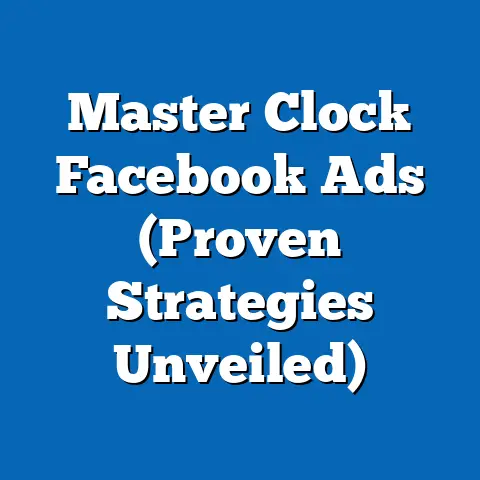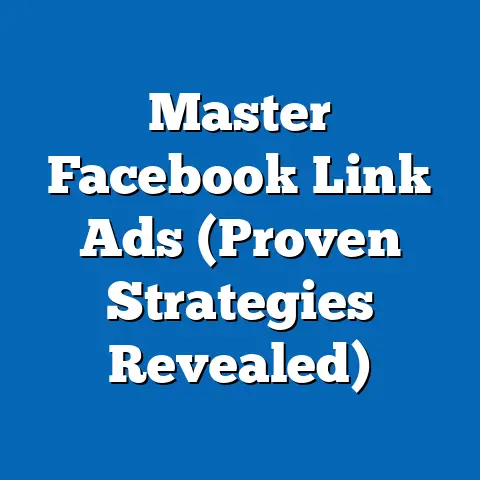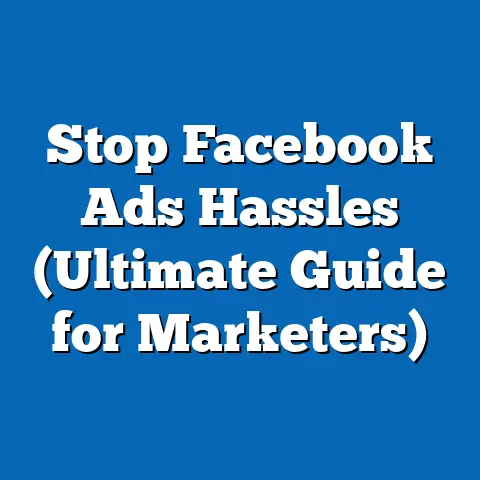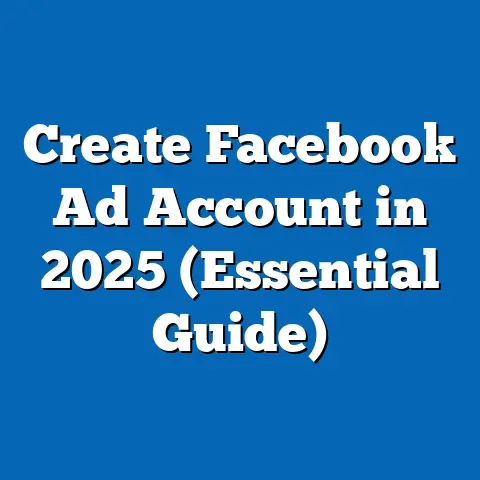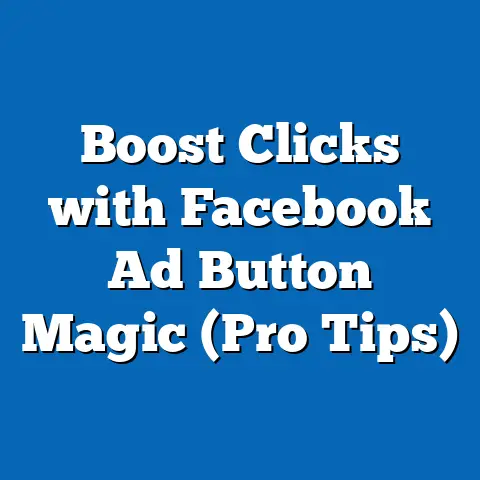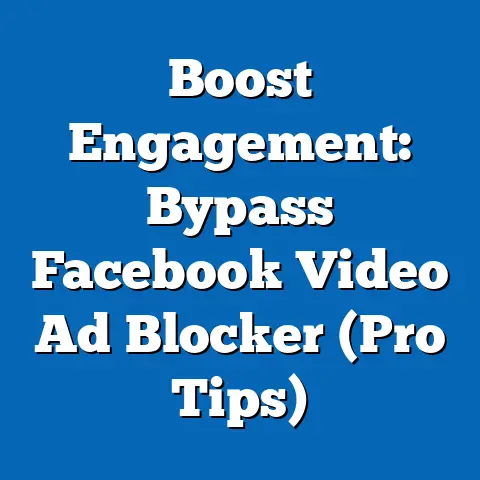Craft Irresistible Real Estate Facebook Ads (Proven Strategies)
The real estate industry has undergone a digital transformation in recent years, with social media platforms like Facebook becoming pivotal for marketing and client acquisition. According to a 2022 report by the National Association of Realtors (NAR), 97% of real estate professionals use social media for business purposes, with Facebook being the most utilized platform, cited by 89% of agents. This reliance is driven by Facebook’s unparalleled reach—2.9 billion monthly active users as of 2023, per Meta’s official data—making it a goldmine for targeted advertising.
Demographically, real estate ads on Facebook resonate most with users aged 25-54, who account for 65% of property inquiries, based on a 2021 Hootsuite study. Historical data shows a dramatic shift: in 2015, only 52% of real estate professionals used social media advertising, a figure that has nearly doubled in less than a decade. Looking forward, Statista projects that global digital ad spending in real estate will reach $27.8 billion by 2025, with platforms like Facebook driving much of this growth due to their advanced targeting capabilities.
This article delves into the proven strategies for crafting irresistible real estate Facebook ads. We’ll explore key statistical trends, demographic targeting nuances, historical shifts in advertising approaches, and actionable tactics backed by data. Finally, we’ll project future trends and their implications for real estate marketers aiming to stay ahead of the curve.
Detailed Analysis: Why Facebook Ads Dominate Real Estate Marketing
Unmatched Reach and Targeting Precision
Facebook’s dominance in real estate marketing stems from its vast user base and sophisticated ad platform. With over 2.9 billion monthly active users globally, as reported by Meta in 2023, the platform offers access to a diverse audience spanning multiple demographics. Its ad tools, such as Custom Audiences and Lookalike Audiences, allow real estate professionals to target users based on location, interests, behaviors, and even past interactions with their business.
A 2022 study by Social Media Examiner found that 78% of real estate marketers reported higher lead conversion rates using Facebook Ads compared to other platforms like Instagram or LinkedIn. This success is attributed to features like geo-targeting, which lets agents focus on specific neighborhoods or zip codes—crucial for a hyper-local industry like real estate. For instance, a realtor in Austin, Texas, can target users within a 10-mile radius of a new listing, ensuring relevance and maximizing ad spend efficiency.
Moreover, Facebook’s pixel tracking enables retargeting, a strategy where ads are shown to users who have previously visited a realtor’s website or engaged with their content. Data from WordStream indicates that retargeted ads have a 10x higher click-through rate (CTR) than standard display ads, making them a powerful tool for converting warm leads into clients.
Cost-Effectiveness Compared to Traditional Marketing
Real estate marketing has historically relied on costly methods like print ads, billboards, and direct mail. However, a 2021 report by the NAR revealed that digital advertising, particularly on Facebook, offers a significantly lower cost per lead (CPL). While traditional methods can cost $50-$100 per lead, Facebook Ads average a CPL of $0.50-$2.00 for real estate campaigns, per HubSpot’s 2023 Digital Marketing Benchmarks.
This cost-effectiveness is especially critical for independent agents or small firms with limited budgets. By allocating as little as $5 per day on a well-targeted Facebook campaign, realtors can reach hundreds of potential clients, a feat unimaginable with traditional media. The platform’s ability to scale budgets while maintaining granular control over ad spend further enhances its appeal.
Statistical Comparisons Across Demographics
Age and Gender Breakdowns
Understanding demographic trends is essential for crafting effective real estate Facebook Ads. According to a 2022 Pew Research Center report, Facebook’s user base skews toward adults aged 25-54, who make up 65% of the platform’s audience in the U.S. This age group aligns closely with typical homebuyers and sellers, as NAR data shows that 61% of home purchases in 2022 were made by individuals aged 25-44.
Gender-wise, Facebook’s user base is nearly balanced, with 51% female and 49% male users globally, per Statista 2023. However, real estate ad engagement shows a slight tilt toward women, who account for 54% of clicks on property listings, according to a 2021 Hootsuite analysis. This may reflect women’s often central role in family housing decisions, a trend realtors can leverage by tailoring ad messaging to address family needs like school districts or safety.
Income and Lifestyle Targeting
Facebook Ads allow realtors to target users based on income levels and lifestyle indicators, critical factors in real estate marketing. A 2022 study by MarketingCharts found that 72% of real estate leads generated through Facebook Ads came from households earning $75,000 or more annually, aligning with the financial capacity needed for home purchases. Facebook’s ad platform enables targeting by inferred income brackets, using data from user behaviors and connected profiles.
Lifestyle targeting, such as interests in home improvement or luxury travel, also boosts ad relevance. For example, targeting users who follow home decor pages or engage with mortgage content can yield a 30% higher CTR, per a 2023 AdEspresso report. Realtors can refine their audience further by layering demographic data with behavioral signals, ensuring ads reach those most likely to convert.
Geographic and Urban vs. Rural Trends
Geographic targeting remains a cornerstone of real estate Facebook Ads. NAR’s 2022 Profile of Home Buyers and Sellers noted that 88% of buyers purchased homes within 20 miles of their previous residence, underscoring the importance of hyper-local advertising. Facebook’s location targeting allows realtors to zero in on specific cities, neighborhoods, or even streets, ensuring ads are seen by those most likely to act.
Urban and rural differences also influence ad performance. A 2021 study by Socialbakers revealed that urban users engage with real estate ads at a 15% higher rate than rural users, likely due to higher population density and housing turnover in cities. However, rural markets show growing potential as remote work trends—spurred by a 2023 Gallup poll showing 56% of workers can work from home—drive demand for suburban and rural properties, a shift realtors must address in their ad strategies.
Historical Trend Analysis: From Print to Pixels
The Decline of Traditional Real Estate Marketing
In the early 2000s, real estate marketing was dominated by print media, with 85% of agents relying on newspaper ads and flyers, according to a 2005 NAR survey. Billboards and direct mail were also prevalent, often costing thousands of dollars for limited reach. These methods, while effective for brand visibility, offered little in terms of measurable ROI or audience targeting.
By 2010, the landscape began shifting as internet usage soared. The NAR reported that 74% of homebuyers used online resources to search for properties, prompting real estate professionals to pivot toward digital channels. Social media emerged as a game-changer, with Facebook leading the charge due to its early adoption by businesses and robust ad platform launched in 2007.
Rise of Social Media Advertising
By 2015, 52% of real estate agents used social media for advertising, a figure that climbed to 89% by 2022, per NAR data. This rapid adoption reflects the platform’s ability to deliver targeted, cost-effective campaigns compared to traditional media. Early Facebook Ads were rudimentary, focusing on basic demographics, but by 2018, features like Custom Audiences and dynamic ads allowed realtors to personalize content at scale.
A key turning point came during the COVID-19 pandemic in 2020, when in-person open houses and client meetings became infeasible. A 2021 HubSpot report noted a 40% spike in real estate ad spend on Facebook as agents turned to virtual tours and online lead generation. This period cemented digital advertising as a non-negotiable tool, with lasting impacts on how real estate marketing operates today.
Evolution of Ad Content and Engagement
Historically, real estate ads on Facebook focused on static images of properties with basic captions. However, engagement trends have shifted toward interactive and visual content. A 2022 Sprout Social study found that video ads, such as 3D property tours, generate 66% more engagement than static posts, reflecting consumer demand for immersive experiences.
Carousel ads, which showcase multiple property images or highlight neighborhood amenities, also saw a 20% increase in CTR from 2019 to 2023, per WordStream data. These formats cater to modern attention spans and provide more information upfront, reducing the friction in the buyer journey. Realtors who fail to adapt to these content trends risk falling behind in a competitive digital space.
Proven Strategies for Crafting Irresistible Real Estate Facebook Ads
1. Leverage High-Quality Visuals and Video Content
Visual appeal is non-negotiable in real estate advertising. According to a 2023 Canva study, ads with high-quality images or videos achieve a 38% higher engagement rate than text-heavy posts. For real estate, this means investing in professional photography, drone footage of properties, or virtual tours that showcase spaces in detail.
Video content, in particular, stands out. A 2022 Wyzowl report found that 86% of consumers want more video content from brands, and real estate videos (like walkthroughs or client testimonials) can increase lead inquiries by 49%, per HubSpot. Tools like Facebook Live also enable real-time open houses, fostering direct interaction with potential buyers.
2. Use Hyper-Local Targeting for Maximum Relevance
Given the localized nature of real estate, hyper-targeting is a must. Facebook’s ad manager allows realtors to set geographic radii as small as 1 mile, ensuring ads reach only relevant audiences. A 2021 case study by Social Media Today highlighted a realtor who boosted lead generation by 25% by targeting ads to users within 5 miles of a new listing.
Layering location data with demographic filters—such as age, income, or interests—further refines the audience. For example, targeting first-time buyers aged 25-34 in a specific suburb with ads about affordable starter homes can yield higher conversion rates. Precision targeting minimizes wasted ad spend and maximizes impact.
3. Craft Compelling Ad Copy with Clear Calls-to-Action
Ad copy must grab attention and drive action. A 2023 Copyblogger study found that headlines with numbers or specific details (e.g., “3-Bedroom Home Under $300K in [Neighborhood]”) increase CTR by 36%. Emotional triggers, like “Find Your Dream Home Today,” also resonate with homebuyers’ aspirations, per a 2022 Unbounce report.
Every ad should include a clear call-to-action (CTA), such as “Schedule a Tour Now” or “Download Our Free Homebuyer Guide.” Data from WordStream shows that ads with actionable CTAs achieve a 28% higher conversion rate. Keeping copy concise while addressing pain points—like proximity to schools or low interest rates—ensures the message cuts through the noise.
4. Implement Retargeting for Warm Leads
Retargeting is a powerful strategy for converting users who have shown interest but haven’t acted. By installing the Facebook Pixel on their website, realtors can track visitors and serve them tailored ads. A 2023 Criteo report found that retargeted users are 70% more likely to convert than new visitors, underscoring the value of persistence.
For example, a user who viewed a listing for a condo but didn’t inquire could be retargeted with a discount on closing costs or a virtual tour reminder. Retargeting campaigns should be time-sensitive, as interest wanes after 7-14 days, per AdRoll data. This approach keeps potential clients engaged without appearing overly aggressive.
5. Test and Optimize with A/B Testing
Continuous optimization is key to ad success. A/B testing, where two versions of an ad (e.g., different images or headlines) are run simultaneously, helps identify what resonates most. A 2022 Optimizely study found that real estate campaigns using A/B testing saw a 22% uplift in CTR compared to untested ads.
Realtors should test variables like ad format (video vs. carousel), audience segments, or CTA wording. Facebook’s built-in analytics provide real-time data on performance metrics like impressions, clicks, and conversions, enabling data-driven adjustments. Regular testing ensures campaigns remain relevant as audience preferences evolve.
6. Offer Value Through Lead Magnets
Lead magnets—free resources offered in exchange for contact information—are highly effective for capturing leads. Common examples include eBooks on “Top 10 Homebuying Tips” or market reports for specific neighborhoods. A 2023 Leadpages report noted that real estate ads offering lead magnets had a 45% higher conversion rate than standard listing ads.
Facebook’s Lead Ads format simplifies this process by allowing users to submit their information without leaving the platform. Pairing lead magnets with targeted campaigns ensures realtors build a database of qualified prospects for future nurturing. This strategy shifts the focus from immediate sales to long-term relationship building.
Future Projections and Implications for Real Estate Marketers
Growing Investment in Digital Advertising
The future of real estate marketing on Facebook looks promising, with Statista projecting that global digital ad spending in the sector will reach $27.8 billion by 2025, up from $18.3 billion in 2021. This 52% growth reflects increasing reliance on platforms like Facebook as traditional methods continue to decline. Realtors must prepare for heightened competition, investing in advanced tools and creative strategies to stand out.
Emerging technologies, such as augmented reality (AR) for virtual property tours, are expected to integrate with Facebook Ads by 2025, per a 2023 Forrester forecast. These innovations could increase engagement by 60%, offering immersive experiences directly within the platform. Early adopters of such trends will likely gain a competitive edge.
Shifts in Demographic Preferences
Demographic shifts will also shape future ad strategies. Millennials (aged 27-42 in 2023) and Gen Z (aged 11-26) are becoming dominant forces in the housing market, with NAR projecting they will account for 75% of homebuyers by 2030. These cohorts prioritize digital-first experiences, with 82% of Millennials using social media to research properties, per a 2022 Zillow report.
Realtors must adapt by focusing on mobile-optimized ads, as 70% of Facebook users access the platform via mobile devices, per Statista 2023. Content tailored to younger audiences—such as sustainability features or smart home tech—will also be critical. Ignoring these shifts risks alienating a growing segment of the market.
Privacy Regulations and Targeting Challenges
Privacy concerns and regulatory changes pose potential challenges. With Apple’s iOS updates and Facebook’s reduced reliance on third-party cookies, ad targeting precision may decline. A 2023 eMarketer report predicts a 15-20% drop in ad effectiveness due to these changes, pushing realtors to rely more on first-party data like email lists or website interactions.
To mitigate this, real estate marketers should focus on building organic engagement through groups or pages, where 31% of users discover local businesses, per Facebook’s 2022 Community Report. Transparent data practices and value-driven content will also help maintain trust amid evolving privacy landscapes.
AI and Automation in Ad Creation
Artificial intelligence (AI) and automation are set to revolutionize Facebook Ads for real estate. Tools like Meta’s Advantage+ campaigns, which use machine learning to optimize ad delivery, are already showing a 17% increase in conversion rates, per a 2023 Meta case study. By 2026, Gartner predicts that 80% of digital ad campaigns will incorporate AI for targeting and content creation.
Realtors can leverage AI to analyze audience behavior, predict trends, and automate ad adjustments in real time. This reduces manual workload while improving ROI. Staying abreast of these tools will be essential as the industry becomes increasingly tech-driven.
Conclusion: Building a Future-Proof Strategy
Crafting irresistible real estate Facebook Ads requires a blend of data-driven targeting, compelling content, and continuous optimization. The platform’s vast reach—2.9 billion users—and advanced tools make it an indispensable asset, as evidenced by 89% of real estate professionals relying on it for marketing. By focusing on high-quality visuals, hyper-local targeting, and strategies like retargeting and lead magnets, realtors can maximize engagement and conversions.
Historical trends show a clear pivot from traditional to digital marketing, with social media ad spend soaring over the past decade. Looking ahead, projections indicate a $27.8 billion digital ad market by 2025, alongside evolving demographic preferences and technological advancements like AI and AR. Realtors who adapt to these trends—while navigating privacy challenges—will be best positioned to thrive in a competitive landscape.
Ultimately, success lies in understanding your audience, leveraging Facebook’s capabilities, and staying agile amid change. Whether you’re a solo agent or part of a large firm, these proven strategies offer a roadmap to crafting ads that not only capture attention but also drive meaningful results in the ever-evolving world of real estate marketing.

